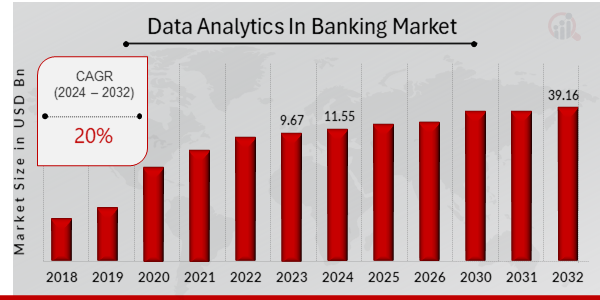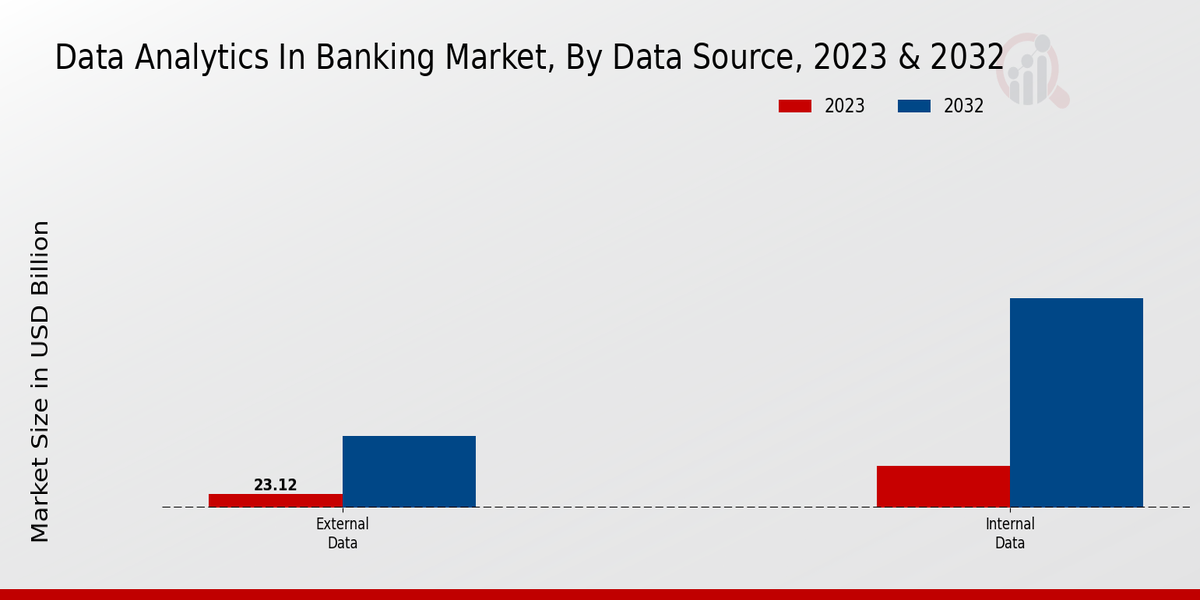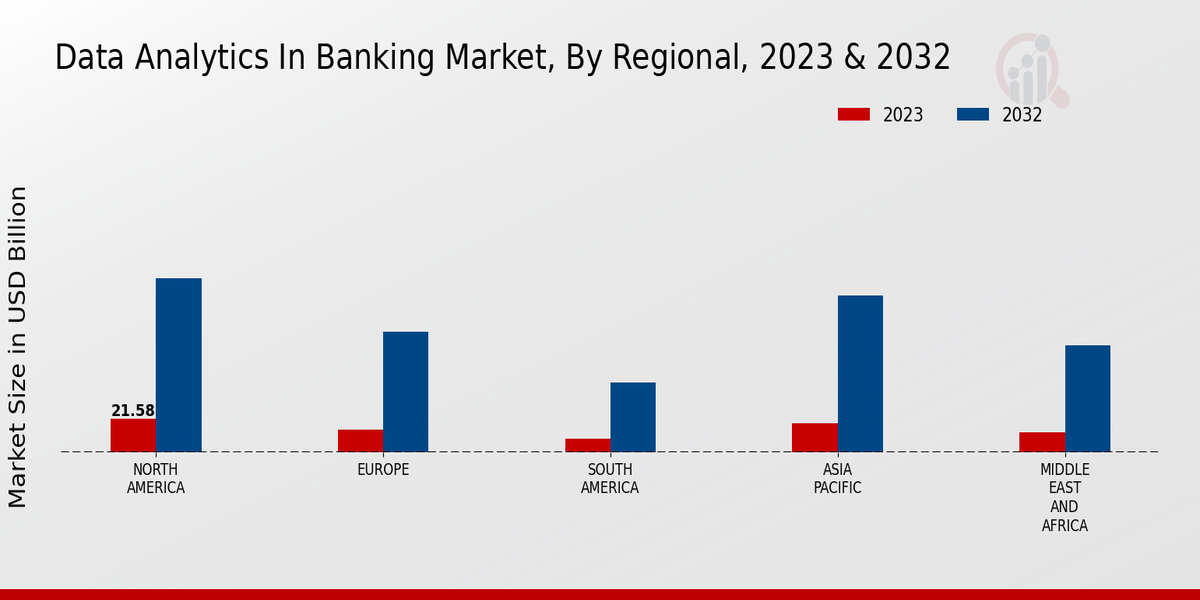Global Data Analytics In Banking Market Overview:
The Data Analytics In Banking Market Size was estimated at 9.67 (USD Billion) in 2023. The Data Analytics In Banking Market Industry is expected to grow from 11.55 (USD Billion) in 2024 to 39.16 (USD Billion) by 2032. The Data Analytics In Banking Market CAGR (growth rate) is expected to be around 20% during the forecast period (2024 - 2032).
Key Data Analytics In Banking Market Trends Highlighted
Digital transformation and increasing data volumes are driving the adoption of data analytics in banking. Banks are leveraging AI and ML algorithms to unlock insights from structured and unstructured data, enabling them to improve customer experiences, optimize risk management, and enhance operational efficiency. The growing demand for real-time data analytics to make informed decisions and combat fraud is further fueling market growth.
Cloud-based data analytics solutions and data visualization tools are emerging as key trends. Banks are realizing the benefits of cloud computing, including scalability, cost-effectiveness, and access to advanced analytics capabilities. Data visualization tools are enabling banks to present complex data in an easily digestible format, facilitating better decision-making and collaboration. Opportunities lie in the integration of data analytics with other banking technologies, such as mobile banking and blockchain. By leveraging data analytics, banks can offer personalized services, improve fraud detection, and enhance risk management. Additionally, the growing adoption of open banking APIs is creating opportunities for data-driven collaborations between banks and third-party providers, leading to innovative solutions and enhanced customer value.

Source: Primary Research, Secondary Research, MRFR Database and Analyst Review
Data Analytics In Banking Market Drivers
Increased Adoption of Cloud and Big Data Technologies
The banking industry is rapidly adopting cloud and big data technologies to improve their data management and analytics capabilities. This is being driven by the need to manage and analyze the vast amounts of data that are being generated by the increasing use of digital banking services, such as mobile banking and online banking. Cloud and big data technologies provide banks with the scalability, flexibility, and cost-effectiveness that they need to meet the demands of their customers. In addition, cloud and big data technologies can help banks to improve their risk management and compliance capabilities. For example, banks can use cloud and big data technologies to identify and mitigate fraud, and to comply with regulatory requirements.
Growing Need for Real-Time Analytics
The banking industry is increasingly recognizing the need for real-time analytics to improve their customer service and operational efficiency. Real-time analytics can help banks to identify and address customer issues quickly, and to optimize their operations in real time. For example, banks can use real-time analytics to identify customers who are at risk of churn, and to take proactive steps to retain them. In addition, banks can use real-time analytics to optimize their marketing campaigns, and to identify opportunities for cross-selling and up-selling. The Global Data Analytics In Banking Market Industry is expected to witness a high demand for real-time analytics solutions.
Increasing Regulatory Compliance Requirements
The banking industry is subject to a number of regulatory compliance requirements, such as the Dodd-Frank Wall Street Reform and Consumer Protection Act and the Basel III Accord. These regulations require banks to have strong data management and analytics capabilities in order to comply with the requirements. For example, banks must be able to track and report on their risk exposure, and they must be able to identify and mitigate fraud. Data analytics can help banks to meet these regulatory requirements in a cost-effective and efficient manner.
Data Analytics In Banking Market Segment Insights:
Data Analytics In Banking Market Data Source Insights
The Data Source segment of the Data Analytics In Banking Market is categorized into Internal Data and External Data. Internal Data refers to data generated within the banking organization, such as transaction records, customer data, and financial statements. External Data, on the other hand, encompasses data acquired from external sources, including market research firms, credit bureaus, and social media platforms. Internal Data is a valuable asset for banks as it provides insights into customer behavior, risk profiles, and operational efficiency. Banks can leverage this data to develop tailored products and services, improve risk management, and optimize their operations. For instance, by analyzing transaction records, banks can identify spending patterns and offer personalized financial advice to customers. As of 2023, the Internal Data segment held a significant share of the Data Analytics In Banking Market and is projected to maintain its dominance throughout the forecast period. External Data, while not as comprehensive as Internal Data, offers unique insights into market trends, competitive landscapes, and customer demographics. Banks can utilize this data to gain a broader perspective of the industry, identify growth opportunities, and develop effective marketing strategies. For example, by analyzing social media data, banks can understand customer sentiment and preferences. The External Data segment is expected to grow at a slightly faster pace than Internal Data, driven by the increasing availability and affordability of data from external sources. Overall, the Data Analytics In Banking Market is expected to witness robust growth over the next decade, fueled by the increasing adoption of data analytics technologies and the growing volume of data generated within the banking industry. As banks continue to invest in data analytics capabilities, the demand for both Internal and External Data is likely to surge, creating significant opportunities for market players.

Source: Primary Research, Secondary Research, MRFR Database and Analyst Review
Data Analytics In Banking Market Type of Data Analytics Insights
The Global Data Analytics In Banking Market is segmented by Type of Data Analytics into Descriptive Analytics, Predictive Analytics, and Prescriptive Analytics. Among these, Descriptive Analytics segment held the largest market share in 2023, accounting for around 40% of the Global Data Analytics In Banking Market revenue. The growth of this segment can be attributed to the increasing demand for data visualization and reporting tools to gain insights into historical data and identify trends. Predictive Analytics segment is expected to witness the highest growth during the forecast period, owing to the growing adoption of machine learning and artificial intelligence (AI) technologies to predict future events and make informed decisions. The prescriptive Analytics segment is also expected to grow significantly, as banks are increasingly looking for solutions that can help them optimize their operations and improve customer service.
Data Analytics In Banking Market Application Insights
The Global Data Analytics In Banking Market is segmented by Application into Fraud Detection, Risk Management, Customer Segmentation, and Marketing Optimization. Fraud Detection is the largest segment, accounting for over 30% of the market in 2023. It is expected to grow at a CAGR of 22% over the forecast period, reaching a value of USD 120 billion by 2032. Risk Management is the second-largest segment, with a market share of over 25% in 2023. It is expected to grow at a CAGR of 20% over the forecast period, reaching a value of USD 100 billion by 2032. Customer Segmentation is the third-largest segment, with a market share of over 20% in 2023. It is expected to grow at a CAGR of 18% over the forecast period, reaching a value of USD 80 billion by 2032. Marketing Optimization is the smallest segment, with a market share of over 15% in 2023. It is expected to grow at a CAGR of 16% over the forecast period, reaching a value of USD 60 billion by 2032.
Data Analytics In Banking Market Deployment Mode Insights
Data Analytics In Banking Market is segmented based on deployment mode into on-premise and cloud based. The cloud-based segment is projected to dominate the market in the coming years due to its benefits such as scalability, flexibility, and cost-effectiveness. The Data Analytics In Banking Market for the cloud-based segment is expected to grow from USD 24.61 billion in 2023 to USD 128.23 billion by 2032, at a CAGR of 22.3%. The major factors driving the growth of the cloud-based segment include the increasing adoption of cloud computing by banks, the need for real-time data analytics, and the growing demand for data-driven insights to improve customer experience and operational efficiency. On the other hand, the on-premise segment is expected to grow at a CAGR of 15.2% during the forecast period. The major factors driving the growth of the on-premise segment include the need for data security and compliance, the large installed base of on-premise data analytics solutions, and the high cost of cloud-based data analytics solutions.
Data Analytics In Banking Market Regional Insights
The Data Analytics In Banking Market is segmented into North America, Europe, Asia Pacific, South America, and the Middle East and Africa. The market in Europe is expected to grow at a CAGR of 19.53% during the forecast period, owing to the growing demand for data analytics solutions from banks and financial institutions in the region. The market in Asia Pacific is expected to grow at a CAGR of 22.23% during the forecast period, owing to the increasing adoption of data analytics solutions by banks and financial institutions in the region. The market in South America is expected to grow at a CAGR of 18.67% during the forecast period, owing to the growing demand for data analytics solutions from banks and financial institutions in the region. The market in the Middle East and Africa is expected to grow at a CAGR of 17.34% during the forecast period, owing to the increasing adoption of data analytics solutions by banks and financial institutions in the region.

Source: Primary Research, Secondary Research, MRFR Database and Analyst Review
Data Analytics In Banking Market Key Players And Competitive Insights:
Major players in Data Analytics In Banking Market industry are continuously focusing on developing advanced data analytics solutions tailored to meet the specific needs of the banking sector. Leading Data Analytics In Banking Market players such as IBM, SAP, Oracle, SAS Institute, and Teradata are investing heavily in research and development to offer comprehensive data analytics platforms that can help banks improve their decision-making processes, optimize operations, and enhance customer experiences. The Data Analytics In Banking Market development is also being driven by the increasing adoption of cloud computing, which enables banks to access scalable and cost-effective data analytics solutions. Additionally, the growing regulatory compliance requirements and the need to manage vast amounts of data are also contributing to the growth of the Data Analytics In Banking Market Competitive Landscape.SAS Institute is a leading provider of data analytics solutions for the banking industry. The company offers a comprehensive suite of data analytics tools and services that can help banks improve their customer segmentation, risk management, fraud detection, and marketing campaigns. SAS Institute's data analytics solutions are used by a wide range of financial institutions, including Bank of America, Citigroup, and Wells Fargo.Teradata is another major player in the Data Analytics In Banking Market. The company offers a range of data analytics solutions that can help banks improve their data management, data integration, and data analysis capabilities. Teradata's data analytics solutions are used by a wide range of financial institutions, including HSBC, JPMorgan Chase, and Royal Bank of Canada.
Key Companies in the Data Analytics In Banking Market Include:
-
Informatica
-
Oracle
-
Microsoft
-
Teradata
-
TIBCO Software
-
Cloudera
-
Splunk
-
SAS Institute
-
SAP
-
QlikTech International
-
IBM
-
MicroStrategy
-
Tableau Software
-
Hortonworks
-
DataStax
Data Analytics In Banking Industry Developments
The Data Analytics in Banking Market is projected to reach USD 399.5 billion by 2032, exhibiting a CAGR of 20.44% during the forecast period (2024-2032). The increasing adoption of digital banking services, growing need for fraud detection and risk management, and regulatory compliance are driving the market growth. Cloud-based analytics solutions, AI-powered analytics, and predictive analytics are gaining traction, offering real-time insights and improving customer experiences. Key players such as SAS, IBM, and Microsoft are investing in R&D to enhance their offerings and gain a competitive edge. Partnerships and acquisitions are shaping the market landscape, with banks collaborating with fintech companies to provide innovative data analytics solutions. The market is expected to witness significant growth in emerging economies as banks focus on digital transformation and data-driven decision-making.
Data Analytics In Banking Market Segmentation Insights
Data Analytics In Banking Market Data Source Outlook
-
Internal Data
-
External Data
Data Analytics In Banking Market Type of Data Analytics Outlook
-
Descriptive Analytics
-
Predictive Analytics
-
Prescriptive Analytics
Data Analytics In Banking Market Application Outlook
-
Fraud Detection
-
Risk Management
-
Customer Segmentation
-
Marketing Optimization
Data Analytics In Banking Market Deployment Mode Outlook
Data Analytics In Banking Market Regional Outlook
-
North America
-
Europe
-
South America
-
Asia Pacific
-
Middle East and Africa
| Report Attribute/Metric |
Details |
| Market Size 2023 |
9.67 (USD Billion) |
| Market Size 2024 |
11.55 (USD Billion) |
| Market Size 2032 |
39.16 (USD Billion) |
| Compound Annual Growth Rate (CAGR) |
20% (2024 - 2032) |
| Report Coverage |
Revenue Forecast, Competitive Landscape, Growth Factors, and Trends |
| Base Year |
2023 |
| Market Forecast Period |
2024 - 2032 |
| Historical Data |
2019 - 2023 |
| Market Forecast Units |
USD Billion |
| Key Companies Profiled |
Informatica, Oracle, Microsoft, Teradata, TIBCO Software, Cloudera, Splunk, SAS Institute, SAP, QlikTech International, IBM, MicroStrategy, Tableau Software, Hortonworks, DataStax |
| Segments Covered |
Data Source, Type of Data Analytics, Application, Deployment Mode, Regional |
| Key Market Opportunities |
AI driven fraud detection Risk management Personalized customer service. Enhanced compliance reporting Streamlined operations |
| Key Market Dynamics |
Increasing adoption of cloud-based solutions. Growing demand for fraud detection and risk management. Rise in regulatory compliance requirements. Integration of AI and machine learning. Expansion of digital banking services. |
| Countries Covered |
North America, Europe, APAC, South America, MEA |
Frequently Asked Questions (FAQ) :
The global Data Analytics in Banking Market was valued at USD 9.67 billion in 2023 and is projected to grow to USD 39.16 billion by 2032, exhibiting a CAGR of 20% during the forecast period.
North America and Europe are the dominant regions in the Global Data Analytics in Banking Market, collectively accounting for over 60% of the market share. The Asia Pacific region is anticipated to witness the fastest growth over the forecast period due to the increasing adoption of data analytics solutions by banks and financial institutions in emerging economies.
Data Analytics is widely used in banking for various applications, including risk management, fraud detection, customer segmentation, product development, and operational efficiency.
Some of the prominent players in the Global Data Analytics in Banking Market include SAS Institute, IBM, Oracle, Microsoft, SAP SE, Teradata, and Alteryx.
The Global Data Analytics in Banking Market faces challenges such as data privacy and security concerns, lack of skilled professionals, and the high cost of implementation and maintenance.
Regulatory compliance is a key factor influencing the adoption of Data Analytics in Banking. Governments worldwide are enacting regulations to protect customer data and ensure responsible use of data analytics technologies.
Emerging trends in the Global Data Analytics in Banking Market include the adoption of cloud-based analytics solutions, the integration of artificial intelligence and machine learning, and the increasing use of data visualization tools.
The adoption of Data Analytics in Banking is anticipated to continue growing rapidly as banks and financial institutions recognize the value of data-driven insights for improving decision-making, enhancing customer experiences, and mitigating risks.
The Global Data Analytics in Banking Market is projected to grow at a CAGR of 20% from 2024 to 2032.
The growth of Global Data Analytics in Banking Market is driven by factors such as the increasing volume and complexity of data, the need for improved risk management and fraud detection, and the desire to enhance customer experiences.

















